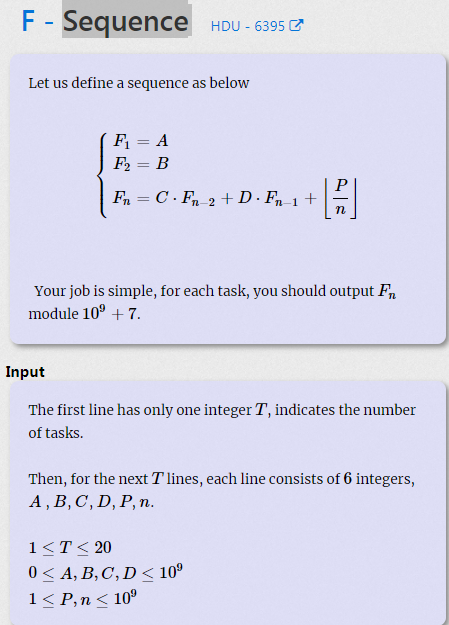热身训练1 Sequence
http://acm.hdu.edu.cn/showproblem.php?pid=6

分析:
这道题,全都是1e9,所以我们很容易想到“矩阵快速幂”。
假如说我们没有后面那个“向下取整”的东西,而将他看作一个常熟C
我们可以很轻松的得到矩阵幂的式子

然后呢,那个常熟C却会随着i变化
我们只需要整除分块,分别进行矩阵幂,这道题就解决了
#include<bits/stdc++.h> using namespace std; #define re register int #define LL long long #define int long long const int mo = 1e9+7; typedef int arr[10][10]; arr A, ans; void modi(arr y, arr x) { arr z; memset(z, 0, sizeof(z)); for(re i=1;i<=3;++i) { for(re j=1;j<=3;++j) { for(re k=1;k<=3;++k) { z[i][j] = (z[i][j] + y[i][k]*x[k][j] % mo) % mo; } } } memcpy(y, z, sizeof(z)); } int a, b, c, d, p, n, q; void Montgomery(int pp) { ans[1][3] = q % mo; memset(A, 0, sizeof(A)); A[1][2]=c%mo; A[2][2]=d%mo; A[2][1]=A[3][2]=A[3][3]=1ll; while(pp) { if(pp&1) modi(ans, A); pp>>=1; modi(A,A); } } inline void work() { scanf("%lld%lld%lld%lld%lld%lld",&a,&b,&c,&d,&p,&n); if(n == 1) printf("%lld\n", a); else if(n == 2) printf("%lld\n", b); else { memset(ans, 0, sizeof(ans)); ans[1][1]=a; ans[1][2]=b; for(re i=3;i<=n;) { q = p/i; int nt; if(q == 0) nt=n; else nt = min(n, p/q); Montgomery(nt-i+1); i=nt+1; } printf("%lld\n", ans[1][2] % mo); } } signed main() { int T;scanf("%lld",&T); while(T--) work(); }
made by kzsn
“向着风拥抱彩虹,勇敢的向前走”
“黎明的那道光,会越过黑暗”
“打破一切恐惧我能,找到答案” ----《你的答案》阿冗


